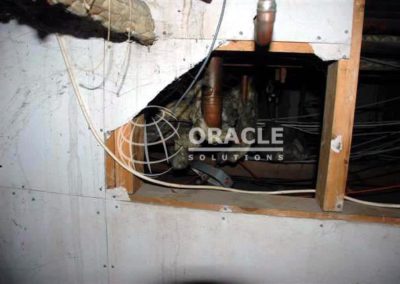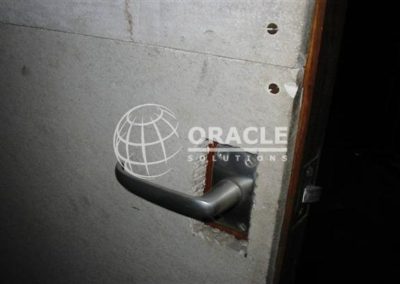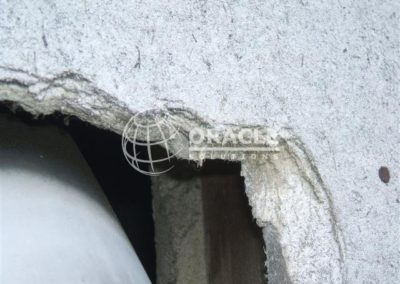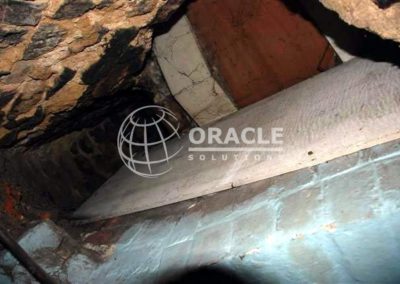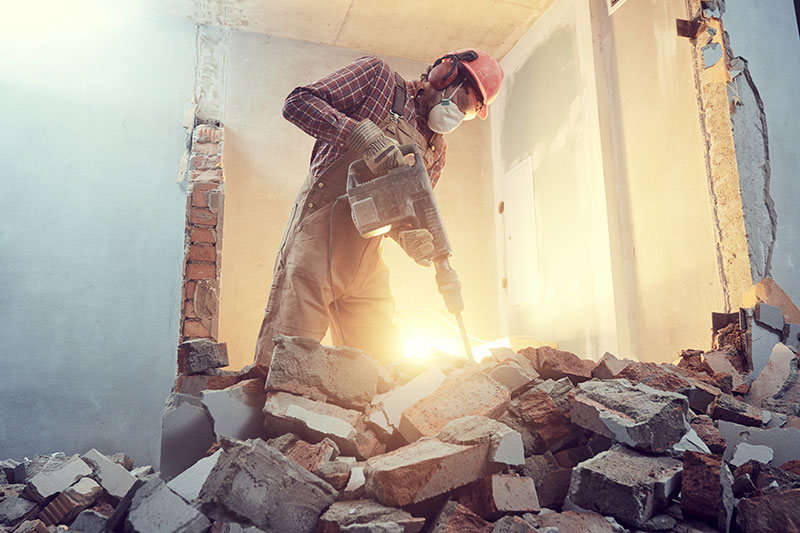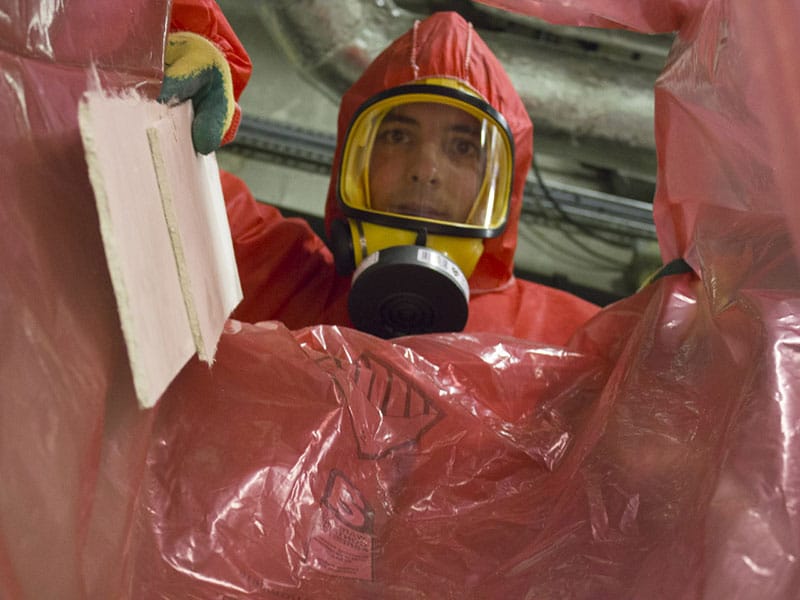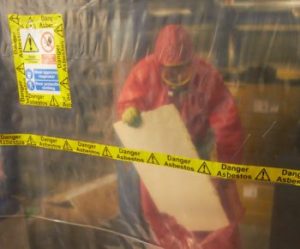The Facts About Asbestos Insulating Board Removal
Asbestos insulating board is a building product that is a mixture of raw asbestos fibre and other materials. Generally, asbestos insulating board is between 20% to 40% asbestos fibre mixed with a calcium silicate material or plaster to give it its more rigid finish. Although in the majority of cases, asbestos insulating board only contains Amosite (Brown) asbestos, there are many occasions where it contains Crocidolite (Blue) asbestos and Chrysotile (White) asbestos or a mixture of any of them.
Asbestos insulating board was predominantly used for fire protection and thermal or acoustic insulation. Asbestos board can be found in many locations within buildings. It was used and is present in in-service ducts, such as fire breaks, infill panels, walls, ceilings, canopies, soffits, and general lining. Due to its ease of use, asbestos insulating board has been used in adhoc places for a variety of purposes throughout buildings. It can virtually be found anywhere in a building suspected to contain asbestos materials.
Table of Content
- How dangerous is uncontrolled asbestos insulating board removal?
- How dangerous is controlled asbestos insulating board removal?
- How is the controlled removal of asbestos insulating board carried out?
- What should I check when using a licensed asbestos removal contractor?
- How much does asbestos insulating board removal cost?
- How can Oracle help with my asbestos insulating board removal?
How dangerous is uncontrolled asbestos insulating board removal?
Uncontrolled removal of asbestos insulating board means to carry out its removal with little or no controls in place that would minimise the risk of asbestos airborne fibre release and subsequent asbestos exposure. The control limit for asbestos is 0.1 fibres per cubic centimetre of air (f/cm3).
This is not the dividing line between asbestos exposure that is safe or dangerous, as all asbestos exposure is potentially harmful. However, asbestos concentrations in the air above this limit have a far greater potential to cause harm.
The uncontrolled removal of asbestos insulating board can result in airborne asbestos fibre levels and exposure to be 10 fibres per centimetre of air. This is 100 times above the current legally documented control limit of 0.1 f/cm3. If you consider that asbestos exposure above the control limit is far more harmful than exposure below that limit, then uncontrolled removal of asbestos insulating board is highly dangerous and should never be undertaken. It is easy to see why removal and working on asbestos insulating board is normally a licensed activity. It should only be undertaken by those licensed by the HSE who have the expertise and competency to carry out the work safely.
How dangerous is controlled asbestos insulating board removal?
Controlled removal of asbestos insulating board involves a hierarchy of control measures designed to minimise fibre release to a level that ensures any potential asbestos exposure is below the control limit of 0.1 fibres per centimetre of air.
The standard control measures that include good fibre suppression/wetting, H type vacuuming, careful handling / minimising breakage and mechanical air flow management will all bring the potential fibre release well under 3 fibres per cubic centimetre of air. In addition to those control measures, correct personal and respiratory protective equipment ensures that those undertaking the work, will not be exposed to any asbestos fibre concentrations above the control limit.
These controls, and the correct implementation of transmitting, decontamination procedures and a suitably enclosed work environment ensure those not directly involved with the asbestos insulating board removal will not be exposed to asbestos fibre concentrations above the control limit of 0.1 f/cm3.
This means that a well-planned carefully managed asbestos insulating board removal undertaken in a controlled manner by a suitably competent and licensed asbestos removal contractor reduces the risks of potential asbestos exposure to an acceptable level.
How is the controlled removal of asbestos insulating board carried out?
When carrying out the removal of asbestos insulating board there are some different approaches. However, there must be a good reason and an adequate assessment to remove asbestos insulating board in any other way than under fully controlled conditions. Removal of asbestos insulating board under fully controlled conditions must include, but is not limited to, the following elements:
- A licensed asbestos removal contractor
- Fully trained and competent asbestos removal operatives
- A fully sealed and segregated asbestos removal enclosure
- Air management systems for the asbestos removal enclosure
- Certified cleaning and dust control equipment for the removal and cleaning process
- Adequate fibre suppression equipment for the removal and cleaning procedure
- An independent UKAS accredited analyst to carry out a 4-stage clearance prior to the reoccupation of the area where asbestos removal has taken place
The following steps give an overview of a standard asbestos insulating board removal project and what must be included.
Step 1: Project Planning
For the removal of asbestos insulating board good project planning is essential. No matter the size of the project. For good project planning and assessing the removal requirements, the following is required as a minimum:
- Analytical identification of the asbestos insulating board through an asbestos survey or sampling exercise. This must include the specific location, quantity, condition and asbestos fibre type of the insulating board to be removed.
- A site visit by the licensed asbestos removal contractor to assess the best way to carry out the removal and to assess other potential risks at the site. This visit must include gathering enough information to complete an appropriate plan of works with risk assessments and must include things such as access, power, water, welfare etc.
- A full and detailed plan of works must be compiled by the licensed asbestos removal contractor in full accordance with HSE approved codes of practice and guidance. The POW must contain the exact details of all control measures to be used to reduce the release of asbestos fibre as far as is reasonably practicable, ensuring the potential for asbestos exposure is minimised.
When all the relevant paperwork and fact-finding have been completed the project now requires notifying the HSE with the exact start date. By law, it is required that prior to licensed asbestos removal work being undertaken, it be notified to the HSE by the licensed asbestos removal contractor 14 days in advance using their online web form ASB5.
Step 2: The Site Setup
To enable work on the asbestos insulating board removal to start, the site must first be made ready. All paperwork and documents must be on-site and be ready for inspection if required. The welfare facilities must be in place and be suitable in accordance with current regulatory requirements. The access and work area arrangements must be checked and found to be suitable.
Prior to work starting, the decontamination facilities must be in place and ready. Decontamination facilities must be via a decontamination/shower unit or similar and must be in full accordance with HSE requirements. Wherever possible, the decontamination unit must be placed as close as is practicable to the work area, and where possible, directly connected to the enclosed workspace. This is to minimise the risk of asbestos contamination spread through transiting where not required.
The work area must be cleared of all items that will not be involved in the project. In many cases, pre-cleaning of the work area will be required before constructing the work enclosure. Sufficient warning signs and appropriate barriers must be in place to warn and protect all those not directly involved in the asbestos removal project.
Step 3: The Enclosure Construction
An enclosure for asbestos removal is one of the control measures used to minimise the risk of asbestos exposure during asbestos insulating board removal. Although it’s a main control measure, it comes after the more important control measures such as careful handling, fibre suppression and delicate removal techniques.
An enclosure is a purpose-built, virtually airtight containment that is constructed generally from timber and polyethylene. The enclosure is constructed where possible using the building elements and then enclosing the area where needed with a timber framework with polythene attached to form the enclosed area. Part of the enclosure construction involves building airlock systems for operatives to transit to and from the area and for asbestos waste to be transited away from the area.
As an additional control measure, the enclosure is placed under negative air pressure. This means that air is drawn into the enclosed space and not away from it. The equipment used for this is ‘Negative Pressure Units’. These units have particulate filters, including disposable sections to ensure asbestos fibre that may become airborne during the removal process are not allowed to escape from the area while it is live, and while asbestos removal is taking place.
To ensure the effectiveness of the enclosure, the airflow and integrity is checked using a smoke machine. Smoke is generated inside the enclosure and from the external, the surrounding areas can be checked for leaks. In addition, how quickly the smoke is cleared when the negative pressure units are switched on, is a good indication of the quality of air movement prior to the asbestos removal taking place.
Step 4: The Asbestos Insulating Board Removal
The site is set up. The decontamination unit is set and ready. The enclosure is constructed and has been checked to ensure it has good integrity and air movement. The workforce has their appropriate personal and respiratory protective equipment. All is now ready to start the actual task of carefully removing the asbestos insulating board.
Out of all the control measures, careful handling techniques and fibre suppression are the most important. The removal technique will depend on how the asbestos board is fixed. If the asbestos insulating board is screw fixed, then the screws are located, and the board is carefully unscrewed, avoiding any breakage. If the asbestos insulating board is nail fixed, then the areas that are nailed are carefully scored with a knife keeping any disturbance to a minimum.
During the removal procedure, the operatives work in pairs so that one operative can apply a good level of fibre suppressant using airless spraying equipment (either hand or machine-dependent upon the size of the project) on all surfaces of the asbestos board and generally in the vicinity of the removal. In addition, vacuuming techniques are used to reduce airborne asbestos fibre concentrations using an approved H type vacuum cleaner.
Removed asbestos insulating board is then carefully bagged or wrapped, ensuring it is double bagged or wrapped and appropriately sealed ready for disposal. This continues until all boards have been removed. Should dust or debris be released as part of the process this is cleared away as the removal progresses.
Step 5: Fine Detailed Cleaning Followed by a Visual Inspection
Once all of the asbestos insulating board has been removed, double bagged/wrapped and transited from the enclosed work area, it is time for the detailed fine clean to take place.
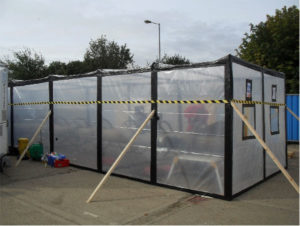
The areas from which the asbestos insulating board has been removed are inspected carefully to ensure no residue of fragments remains. Once the entire area has undergone a fine and detailed clean to remove all dust from every surface, the asbestos removal supervisor undertakes a thorough visual examination. This is to ensure the area is suitably clean and ready for an independent analyst to carry out their visual inspection as part of their 4 stage clearance procedure.
Step 6: The 4 Stage Clearance Procedure
As part of the legal requirements with asbestos insulating board removal, the 4-stage clearance is a vital step. This must be undertaken by an independent, fully qualified and UKAS accredited analyst. The asbestos removal team must work hand in hand with the analyst to ensure that this stage of the asbestos removal work is undertaken without hindrance.
The 4-stage clearance procedure includes:
Stage 1: Preliminary check of site condition and job completeness
The analyst will establish the scope of work and ascertain whether it has been carried out accordingly. They will also check the site files to ensure all associated information is present and up to date.
Once complete, they will then conduct a visual assessment of the site to check that the removal enclosure is intact, that the site decontamination unit is operational and the work area, transit and waste routes are free from unnecessary clutter and any obvious contamination that has arisen as a result of the removal work.
Once they are happy these conditions have been met and that they can begin an inspection of the work enclosure, they sign off and move onto stage two.
Stage 2: A thorough visual inspection inside the enclosure/work area
Initially, the analyst will inspect the removal area to check for any residual material or fallen debris, but all areas of the enclosure, including the airlocks and bag locks, are inspected for debris and dust.
Microscopic asbestos contamination is easily spread within the enclosure during the removal process, so it is important to inspect all surfaces within the work area to ensure they have been suitably cleaned.
Once deemed clean to a suitable standard, the analyst can move onto stage three. If deemed not to be of suitable cleanliness, then the removal contractor will undertake further cleaning until the analyst is satisfied.
Stage 3: Air monitoring
Testing and analysis for asbestos fibres (including asbestiform fibres that fit the respirable criteria) are then carried out. The work enclosure is brushed at the start of the sample run to disturb any unseen fine settled dust that is likely to contain asbestos fibres. Such dust could give rise to high exposure levels during the dismantling of the enclosure or subsequent cleaning/maintenance activities in the work area.
Samples are collected on filters which are removed from the enclosure and counted on-site using PCM (Phase Contrast Microscopy). Should the air tests be assessed as suitably clean, stage 3 can be signed off, ready for the dismantling of the removal enclosure.
Stage 4: Final assessment post-enclosure/work area dismantling
This is a ‘backstop’ to check for any materials released as the enclosure is taken down. For example, it’s possible they were trapped within the folds of the enclosure material.
The analyst will check the more general work for any residual problems, including a revisit of the transit and waste routes.
Minor issues can normally be cleaned easily before the fourth stage is completed, but in extreme (and very rare) cases, the enclosure may need to be reinstated and the work redone.
Once all four stages are complete, and only after the fourth stage is signed off, a certificate of reoccupation is issued.
Step 7: Decanting from Site & Disposal of Asbestos Waste
Once the 4-stage clearance test is complete and the work enclosure has been dismantled, all other equipment and site materials are loaded and made ready for departure from the site. If the asbestos waste has been stored within a waste container, this is removed from the licensed waste carrier site.
In some instances where smaller amounts of asbestos waste have been generated, a bespoke waste van will be used to transfer the waste from the site to a relevant asbestos waste transfer station. This waste haulage must also be undertaken by someone suitably licensed to carry asbestos waste.
Prior to leaving site, the asbestos removal contractor will ensure that the customer has a copy of the certificate of reoccupation so that they have confirmation that the area where asbestos removal was undertaken is ready for normal occupancy.
What should I check when using a licensed asbestos removal contractor?
When it comes to ensuring your asbestos removal contractor is suitable for the project, there are some easy checks that will indicate their suitability. Firstly, ensure that they have and send you the following relevant information:
- A copy of their in-date HSE asbestos removal license
- A copy of their in-date Insurance cover for licensed asbestos removal
It is a good check to visit the HSE database of licensed asbestos removal contractors to check that their license is in date and that they have no actions against them from the HSE (https://webcommunities.hse.gov.uk/). We would strongly recommend that you do not use a contractor who has a history of HSE action against them.
With insurance, the minimum you should expect a good asbestos removal contractor to have in place is:
- Professional Indemnity £ 5,000,000
- Public Liability £ 10,000,000
You should ensure both elements meet this minimum value and that they are in date. You will be taking their advice and it is imperative that you are covered should they make a mistake or if something happens, that could affect you as a result of them undertaking work for you.
The above are minimum requirements. You can make many more checks; however, our biggest advice is to ask for at least three references from reputable organisations who they have recently undertaken similar work for. There is nothing better than speaking with another organisation that has firsthand experience of their quality and working procedures.
How much does asbestos insulating board removal cost?
The cost of asbestos insulating board removal will vary dependent upon a large number of factors that need to be considered for its safe removal and disposal. The main items that will affect the price of asbestos insulating board removal are:
- Location, condition, quantity and how it’s fixed
- Access requirements such as high-level scaffolding etc.
- On-site services such as power, water, and welfare provision
When you receive your quotation and study the price, it is important to remember the volume of planning, labour, equipment and other unforeseen costs that must be included in such a project. A very small and simple project that would usually take two days to complete can be more than £2000. The following is a minimum requirement for a small 2-day project.
- Project planning site visit by a suitable manager
- Preparation of all paperwork including POW, risk assessments and ASB5 notification
- Minimum labour of 2 operatives for two days
- All materials to set the relevant enclosures and areas of work
- All materials for the removal process, cleaning, decontamination, and disposal
- All personal and respiratory protective equipment, including disposable towels, overalls, underwear, filters etc.
- Equipment for the project such as air management units, decontamination unit, fibre suppression equipment and all disposable items relevant to these.
- A four-stage clearance by an independent accredited analyst
In addition, it is worthy of note that the contractor must ensure adequate insurance for asbestos work, suitable training, medical surveillance, regular maintenance, and certification for all equipment, including RPE/PPE. The list of requirements is far larger than this and includes quality management systems/auditing, health and safety requirements, asbestos exposure monitoring, transportation etc.
Taking all these minimum items into consideration, it is easy to see why the cost to remove asbestos insulating board is higher than general demolition or removal works for non-asbestos materials. As the cost differs so much depending upon each individual project and the requirements for that project, should you require a cost, the Oracle team pride themselves on quickly providing customers with quotations and detailed pricing. Call a member of the team and they will be happy to help you.
How can Oracle help with my asbestos insulating board removal?
Oracle is a licensed asbestos removal contractor. We have a large experienced and competent team located throughout the whole of the UK. We have many years’ experience undertaking asbestos removal of all types, including asbestos insulating board. We have a one-stop shop approach for all our customers and can offer and deliver every asbestos service you would ever need.
Oracle Solutions are:
- HSE Licensed – For asbestos removal and remediation
- UKAS Accredited – For asbestos surveying and testing
- Environment Agency Licensed – For asbestos transportation
- Environment Agency Licensed – For asbestos disposal
Here are some of the services we offer. For the complete range, please view our website or call the team for more information.
- Asbestos Removal
- Asbestos Repair & Encapsulation
- Asbestos Surveying (All types)
- Asbestos Air Testing
- Asbestos Contaminated Soil surveying, Removal & Excavation
- Asbestos Waste Transportation
- Asbestos Waste Disposal
- Full Asbestos Management Service – Risk Assessment & Planning

